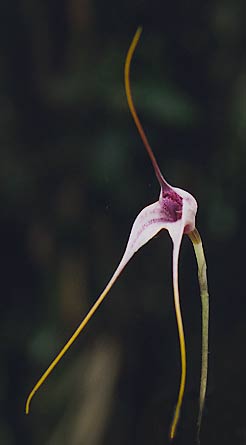Introduction
 |
Masdevallia picta
from Tapichalaca |
In November 1997 Robert Ridgely, John Moore,
Mercedes Rivadeniera, and Lelis Navarette discovered a spectacular
bird new to science, the Jocotoco Antpitta, in southern Ecuador.
It was a stunningly unexpected discovery that made a big splash
in the bird world. Fortunately the ornithologists who discovered
the bird were very concerned for its survival, and they vowed
to protect this severely threatened forest. They started a
foundation, the Jocotoco
Foundation, and got other ornithologists and
conservationists involved. With the financial help of Nigel
Simpson and others, they were able to buy the original Jocotoco
Antpitta site, naming it the Tapichalaca Reserve. Since then,
they have continued to raise money and buy up habitat for
other severely endangered Ecuadorian birds, and they now own
six reserves totalling six thousand hectares. This remarkable
foundation, led by the foremost neotropical ornithologists,
has virtually no overhead and a tightly focussed mission,
and is the best example of private-initiative conservation
that I have seen in Latin America. For more information about
them, see their website.
 |
Lepanthes ctenophora
from Buenaventura Reserve |
Their reserves do not just
protect birds. The same forces that drive the evolution of
restricted-range birds are even more effective on plants,
because a minimum viable population of a plant species can
survive in a much smaller area than the equivalent number
of birds. Plant endemism is thus far more frequent than bird
endemism in Ecuador, and many plants seem to have very narrow
habitat requirements and extremely localized populations.
It is reasonable to expect that the Jocotoco reserves, which
protect large tracts of very special bird habitats, should
also be important sites for endangered plants. I am investigating
the plants of these reserves, concentrating on the family
Orchidaceae, the largest plant family in Ecuador and the one
with the highest number of restricted-range species. This
web page reports the ongoing results of that investigation.